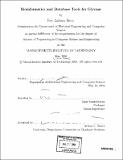| dc.contributor.advisor | Ram Sasisekharan. | en_US |
| dc.contributor.author | Berry, Eric Zachary, 1980- | en_US |
| dc.contributor.other | Massachusetts Institute of Technology. Dept. of Electrical Engineering and Computer Science. | en_US |
| dc.date.accessioned | 2005-09-06T21:39:59Z | |
| dc.date.available | 2005-09-06T21:39:59Z | |
| dc.date.copyright | 2004 | en_US |
| dc.date.issued | 2004 | en_US |
| dc.identifier.uri | http://hdl.handle.net/1721.1/27085 | |
| dc.description | Thesis (M. Eng. and S.B.)--Massachusetts Institute of Technology, Dept. of Electrical Engineering and Computer Science, 2004. | en_US |
| dc.description | Includes bibliographical references (leaves 75-76). | en_US |
| dc.description.abstract | Recent advances in biology have afforded scientists with the knowledge that polysaccharides play an active role in modulating cellular activities. Glycosaminoglycans (GAGs) are one such family of polysaccharides that play a very important role in regulating the functions of numerous important signaling molecules and enzymes in the cell. Developing bioinformatics tools has been integral to advancing genomics and proteomics. While these tools have been well-developed to store and process sequence and structure information for proteins and DNA, they are very poorly developed for polysaccharides. Glycan structures pose special problems because of their tremendous information density per fundamental unit, their often-branched structures, and the complicated nature of their building blocks. The GlycoBank, an online database of known GAG structures and functions, has been developed to overcome many of these difficulties by developing a common notation for researchers to describe GAG sequences, a common repository to view known structure-function relationships, and the complex tools and searches needed to facilitate their work. This thesis focuses on the development of GlycoBank. In addition, a large, NIGMS-funded consortium, the Consortium for Functional Glycomics, is a larger database that also aims to store polysaccharide structure-function information of a broader collection of polysaccharides. The ideas and concepts implemented in developing GlycoBank were instrumental in developing databases and bioinformatics tools for the Consortium for Functional Glycomics. | en_US |
| dc.description.statementofresponsibility | by Eric Zachary Berry. | en_US |
| dc.format.extent | 76 leaves | en_US |
| dc.format.extent | 4163415 bytes | |
| dc.format.extent | 4171278 bytes | |
| dc.format.mimetype | application/pdf | |
| dc.format.mimetype | application/pdf | |
| dc.language.iso | en_US | |
| dc.publisher | Massachusetts Institute of Technology | en_US |
| dc.rights | M.I.T. theses are protected by copyright. They may be viewed from this source for any purpose, but reproduction or distribution in any format is prohibited without written permission. See provided URL for inquiries about permission. | en_US |
| dc.rights.uri | http://dspace.mit.edu/handle/1721.1/7582 | |
| dc.subject | Electrical Engineering and Computer Science. | en_US |
| dc.title | Bioinformatics and database tools for glycans | en_US |
| dc.type | Thesis | en_US |
| dc.description.degree | M.Eng.and S.B. | en_US |
| dc.contributor.department | Massachusetts Institute of Technology. Department of Electrical Engineering and Computer Science | |
| dc.identifier.oclc | 56820961 | en_US |
